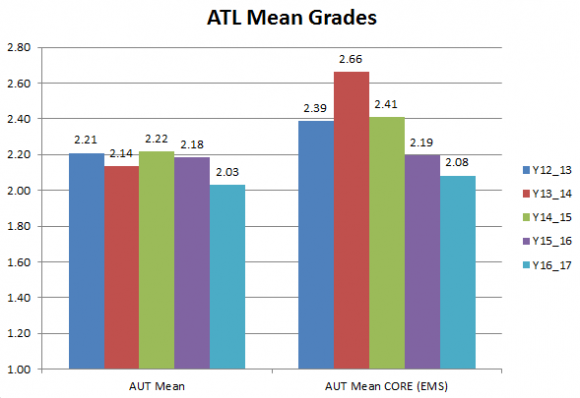 So the data has been interrogated and discussed. It has been prepared and shared with those who can use it to make a difference. It is important to know that the bands are calculated employing statistical principals and as a result each cohort or year group, will recognise approximately the same number of students in each band, each time the ATL grades are collected (three time a year). The form of the bell may change slightly (reflecting the students ATL) however year groups can be compared and mean scores and standard deviations be used to trend progress and dispersions of ATL within a cohort or year band (or that is as I understand it). Not to mention the obvious mean year comparisons, core vs mean comparisons and standard deviations.
So the data has been interrogated and discussed. It has been prepared and shared with those who can use it to make a difference. It is important to know that the bands are calculated employing statistical principals and as a result each cohort or year group, will recognise approximately the same number of students in each band, each time the ATL grades are collected (three time a year). The form of the bell may change slightly (reflecting the students ATL) however year groups can be compared and mean scores and standard deviations be used to trend progress and dispersions of ATL within a cohort or year band (or that is as I understand it). Not to mention the obvious mean year comparisons, core vs mean comparisons and standard deviations.
| AUT Mean | AUT Mean CORE (EMS) | AUT STDEV | |
| Y12_13 | 2.21 | 2.39 | 0.69 |
| Y13_14 | 2.14 | 2.66 | 0.60 |
| Y14_15 | 2.22 | 2.41 | 0.57 |
| Y15_16 | 2.18 | 2.19 | 0.58 |
| Y16_17 | 2.03 | 2.08 | 0.53 |
Step 3 – Use and act upon the information the data highlights
It is our aim to collect the ATL grades three times a year, reporting the ATL bands to students, parents and carers through reports. Also, we have compared the ATL bands to the CAT bands and that has revealed a number of concerning miss matches. Students with high abilities but low ATL bands. As we know, the data rises questions rather than providing answers.
Introduce and support the use of ATL bands with our Community Leaders and Directors of Progress to either reward or address ATL performance, more of that in a moment.
I am running assemblies on aspiration, a part of which is to educate the students and what each ATL Bands signifies. There is not much to it.
Meanwhile Community Leaders are delivering ATL rewards stars to students in Band 9 and 8 (Gold and Silver) in person. Band 9 students are also scheduled to meet with the Principal with a personalised letter home. Band 8 students also receive a letter home. The stars are metallitic gold and silver tie pins, these can be traded in on a year basis for silver and gold bars. A gold star, at any cycle, and at least two further silver stars entitles you to trade in for a gold bar. Two silver stars, for two of the three cycles, can be traded in for a silver bar. That way, we get most of our stars back, students will have space on their blazers and we also reward prolonged good behaviour. Hence the stars and bars ATL rewards programme.
At the other end of the bell shaped curve, letters have been sent to parents and carers of students in Band 3, 2, and 1; this information then informs or triggers the behaviour management strategies in already place with a number of students in Band 1, 2 and 3 placed on report for one week to offer the students the opportunity to ‘get it right.’.
This coincides with Community Leaders proactively inviting the parents or carers of students in Band 1 or 2 to book an appointment. Or course, having the ATLs from all subject areas puts our staff in a position to discuss the students ATL, rather than experience repeated, short negatives conversations at parents and carer meetings. Parents or carers of students in Band 3 are asked to attend the next parent and careers meeting event.
Mentors are also given the bands for their mentees. Mentors have been asked to add a simple note in planner of students in Band 4. Hamble ‘G’ (a positive stamp used for prolonged effort) for students in Band 6. The band also offers an excellent conversation point for academic mentoring or a reference point for Parent and Carer meetings. As curriculum teachers, I am sure that staff will find the data useful, in either recognising ATL trends, or ALT anomalies.
At the moment I only have the short term overview of the project. We have had supportive correspondence for under-performing students in Y11 requesting appointments. We have had some pleasantly surprised students sent to see the Principal. We have had students not in the top 2 or bottom 3 asking about what band they are in? Feedback from Community Leaders has been positive, that it was a refreshing to meet and reward the positives.
With the mean ATL grades collected over three cycles, we will be able to identify school ATL trends, potentially with extra work, individual student trends. Whether students are engaging with school or whether they are distancing themselves. This could prove to be a valuable forecasting tool.
Questions
Applications for prefects – should students below a particular band be interviewed for a prefect position,?
Should prefects in band 5 retain their position?
I would suggest that parent and carer events, for parents and carers of students in Band 3, 2, and 1 is not a particularly pleasant experience. At least, not an experience that encourages their attendance. How can we best support students, parents and carers in Bands 2 or 1?
How can the summary mean and median data summaries be used to focus curriculum intervention and SLT support? Comparing core and foundation subjects, looking at comparisons within cores and foundation subjects.
Looking at the ATL of key sub groups, for able gifted and talented and SEN A, P and SEN.
ALT Bands Spreadsheet – I am more than happy to share the master spreadsheet, if you think it will enable your school to make more of the ATL or effort grades we all seem to be collecting.
[qr_code_display]



